 Today,
most submarines are divided into categories according to the weapons, or lack
of, that they carry. Research submarines are the ones built in the smallest
numbers and are shaped quite differently from most 'standard' subs. They are
very mission specific. For military submarines, there are coastal defense
versions that rely on torpedoes as their main armament. These are generally
conventionally powered. Nuclear submarines are often divided into two classes.
One are the long range missile carrying types or 'boomers' that have ICBM or
IRBM subsurface to surface ballistic missiles. The others are more reminiscent
of the submarines of WWII in that their main armament are torpedoes and these
are the 'fast attacks'. Their job is not so much to hunt down surface shipping,
though they can with their long range subsurface to surface cruise missiles, but
to hunt enemy submarines.
Today,
most submarines are divided into categories according to the weapons, or lack
of, that they carry. Research submarines are the ones built in the smallest
numbers and are shaped quite differently from most 'standard' subs. They are
very mission specific. For military submarines, there are coastal defense
versions that rely on torpedoes as their main armament. These are generally
conventionally powered. Nuclear submarines are often divided into two classes.
One are the long range missile carrying types or 'boomers' that have ICBM or
IRBM subsurface to surface ballistic missiles. The others are more reminiscent
of the submarines of WWII in that their main armament are torpedoes and these
are the 'fast attacks'. Their job is not so much to hunt down surface shipping,
though they can with their long range subsurface to surface cruise missiles, but
to hunt enemy submarines.
With the fall of the Iron Curtain, both types have been
steadily removed from service without a one for one replacement as in the past.
The result is fewer boats of both types. However, those that remain are much
more capable than the boats of the past and still able to provide the deterrent
and attack capabilities as in the past. For example, most the the cruise
missiles that fell on Baghdad during the Bush invasion of 2003 came from fast
attack submarines cruising in the Red Sea. These were able to hit pin-point
targets without damaging surrounding neighborhoods.
In this book, the author Jim Christley, himself a man who
served on submarines, tells the story of the fast attack from its inception
based on the US' first nuclear powered submarine USS Nautilus to the
current fleet boats such as the USS Texas and USS Hawaii. All of
the salient features of these boats, including their propulsion systems,
weapons, sensor arrays and the very design of the hulls themselves are covered,
making for a great primer on the subject. This is further enhanced by superb
period photos and the excellent artwork of illustrator Tony Bryan.
Whether you are a long time fan of submarines or just
learning about them, this is a book you will surely enjoy. It is one that I can
readily recommend to you.
September 2007
For more on the complete line of Osprey books,
visit www.ospreypublishing.com. In the US, it is
Osprey Direct at 44-02 23rd St, Suite 219, Long Island City, NY 11101., where you can
get a catalogue of available books.
If you would like your product reviewed fairly and quickly, please contact
me or see other details in the Note to
Contributors.
 Today,
most submarines are divided into categories according to the weapons, or lack
of, that they carry. Research submarines are the ones built in the smallest
numbers and are shaped quite differently from most 'standard' subs. They are
very mission specific. For military submarines, there are coastal defense
versions that rely on torpedoes as their main armament. These are generally
conventionally powered. Nuclear submarines are often divided into two classes.
One are the long range missile carrying types or 'boomers' that have ICBM or
IRBM subsurface to surface ballistic missiles. The others are more reminiscent
of the submarines of WWII in that their main armament are torpedoes and these
are the 'fast attacks'. Their job is not so much to hunt down surface shipping,
though they can with their long range subsurface to surface cruise missiles, but
to hunt enemy submarines.
Today,
most submarines are divided into categories according to the weapons, or lack
of, that they carry. Research submarines are the ones built in the smallest
numbers and are shaped quite differently from most 'standard' subs. They are
very mission specific. For military submarines, there are coastal defense
versions that rely on torpedoes as their main armament. These are generally
conventionally powered. Nuclear submarines are often divided into two classes.
One are the long range missile carrying types or 'boomers' that have ICBM or
IRBM subsurface to surface ballistic missiles. The others are more reminiscent
of the submarines of WWII in that their main armament are torpedoes and these
are the 'fast attacks'. Their job is not so much to hunt down surface shipping,
though they can with their long range subsurface to surface cruise missiles, but
to hunt enemy submarines.